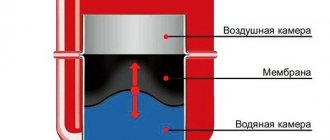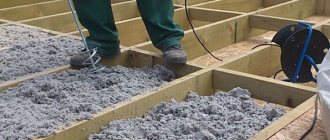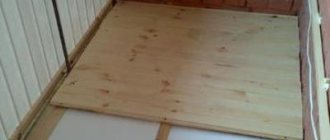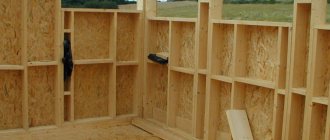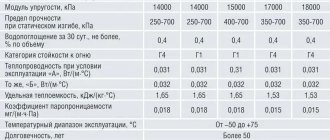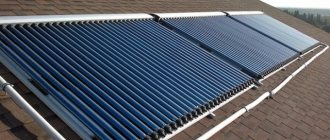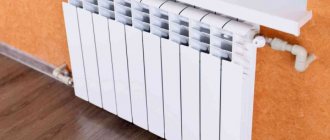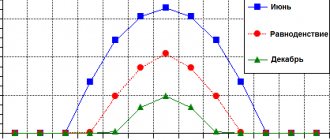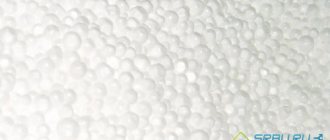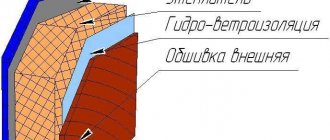Wind protection functions
Wind protection for walls plays an important role in construction. The need for its use can be explained using two main sources of heat leakage:
- infiltration - is the leakage of a warm air flow through pores, crevices and cracks in the walls;
- airflow (sometimes it reaches 90%) - since even the densest insulation structures have pores, air spreads throughout the insulation, thereby reducing its productivity.
That is why the wind protection has the ability to regulate the temperature in the room.
It also prevents the appearance of unpleasant and harmful to people’s health – mold and mildew, which appear due to a drop in temperature and condensation.
It’s hard to imagine how favorable the environment would be for their appearance. In the modern world, the market is simply overcrowded with a wide range of our and foreign products for wind protection.
Based on their characteristics, they can be divided into:
- vapor-permeable - through them, steam from the insulating layer freely escapes to the outside. They also store it from moisture and cold wind flow and install it outside the building.
- vapor barriers - installed inside the building and protect against moist air flow in the heated space.
Functions of the windproof membrane
The climate of our regions is characterized by periodic strong winds. In combination with high humidity, the air flow, penetrating through the sheathing, negatively affects the insulation, due to which the performance qualities of the heat insulator may decrease.
The windproof membrane creates reliable protection without affecting vapor permeability.
In addition, the film is ideal for structures built from porous materials (brick, foam blocks, wood, etc.). It blocks access to air flows that easily penetrate microcracks.
This contributes to a favorable indoor microclimate, preventing the formation of condensation and, as a consequence, microbiological processes.
Sheet materials
They are a material formed into thin pieces or sheets for insulation and weather protection of buildings. Today, Isoplat slabs are especially popular.
They are used to protect the structures of external walls, ceilings, and roofs of buildings. They have wonderful windproof, insulating, soundproofing, water and steam impervious functions, and enhancing the durability of the building. This allows one substance to solve all problems with all types of insulation at once. They are specially designed for use in humid climates. Since the slab is thoroughly impregnated with paraffin, which contributes well to high resistance to negative weather conditions. The slabs protect the house, prevent moisture from penetrating the insulation layer and act as a protective layer from wind, snow and rain without external cladding. To make the building photogenic, you can cover the top of the slabs with plastic, stone or wood. But be sure to leave a space of 20-50 mm between the slab and the cladding.
Pros and cons of windproof film
Advantages of the material:
• environmental friendliness (there are no harmful and toxic substances in the composition);
• fire resistance (achieved thanks to special additives);
• ease of use (installation technology does not require the use of special equipment);
• moisture resistance;
• does not lose properties under the influence of ultraviolet radiation;
• elasticity allows you to avoid deformation during installation;
• does not change quality and characteristics due to sudden temperature changes;
• long operating period.
Among the disadvantages not of the membrane itself, but of its application, it can be noted that incorrect installation leads to a deterioration in the thermal properties of the facade. A loose fit of the film to the insulation layer provokes the formation and accumulation of condensation on the insulation side.
Also, some builders forget about the need to leave a ventilation gap between the membrane and the cladding.
Types of windproof films
Windproof films with external insulation are widely used. They go well with walls made of concrete and brick or wood. It is also worth considering that it can be used to insulate not only walls, but also floors, ceilings, and roofs. Today there are such types of windproof films: moisture-windproof and superdiffusion membranes. Moisture and windproof ones have two layers: the outer one is smooth, which perfectly protects against splashes and powder, and the inner one is porous. In addition to the fact that they quickly remove moisture, they also provide good pressure resistance. They also have a high level of steam transmission (3000 g/m2 per day), but at the same time their water resistance is quite small - 200-250 mm.
Polyethylene membranes
Polyethylene membranes are the most cost-effective means for wind protection of buildings. Since polyethylene prevents structures from getting wet and protects them from blowing, but at the same time it has low permeability and resistance to temperature changes - the choice will be yours. Remember, in any case, this is a strong material, without pores, which does not allow water to pass through, which is why steam accumulates, turns into droplets of water, and penetrates the seal layer, gradually destroying it.
Insulation materials
161 votes
+
Vote for!
—
Vote against!
Windproof membrane is a fairly new material on the construction market. Its demand began to grow with the peak of popularity of the construction of frame houses. But besides this, such a membrane material is very important not only when insulating the walls of a house, but also when arranging the roof, where it has become an integral layer of the “pie”. This stage during construction work should be provided for at the design stage or at the very beginning of repairs. This article will discuss how to choose a windproof membrane for your home and install it correctly.
The importance of a hydro and windproof membrane for the home
- Regardless of what material the house is built from, when insulating it, it is imperative to provide a windproof layer. Its task is to protect the thermal insulation material from the effects of strong air currents, partially absorbing air pressure. But, at the same time, without in any way reducing the vapor-permeable characteristics of the material with which the facades of the house are lined. Therefore, we can conclude that it is the windproof membrane that guarantees the preservation of all the important characteristics of the insulation, allowing you to extend its service life.
- But we must not forget that from the inside of the house you need to make a vapor barrier membrane film that will protect the insulation from water vapor. When wet, it immediately deteriorates its properties and high heat loss begins.
Tip: a windproof single-layer or double-layer membrane is used only on the outside on top of the insulation, and a vapor barrier membrane is used on the inside of the house, as a finishing layer before installing drywall.
- The importance of using windproof membranes is due to several factors. First of all, this is infiltration, that is, when warm air from the house passes out through very small cracks in the structure of the wall material. This occurs especially often in wooden houses when the wood dries out. The second reason is the ventilation of the walls. Even dense materials such as brick or foam block have sufficient porosity to allow air to pass through. The presence of a windproof film helps to cope with these shortcomings, and, without affecting the vapor barrier qualities, stabilize the microclimate in the room.
- In addition, the use of wind protection will protect the insulation from excess moisture due to condensation, which often causes mold to form.
Today there is a very wide variety of windproof membranes on sale, both foreign and domestic. They all vary greatly in price and features. According to their technical characteristics, windproof membranes for the home can be divided into:
- vapor-permeable film , promotes the penetration of excess steam from the room, while protecting the insulation from rain and cold winds;
- vapor barrier film attached to the living room side. Its function is only to remove steam; it cannot be mounted outside;
- multifunctional membrane , its name speaks for itself. Despite its apparent convenience, it is used much less frequently.
Benefits of using a windproof membrane
- Environmental friendliness of the material . It is absolutely harmless to both humans and the environment.
- Fire resistance . It is achieved thanks to the special additives that it contains. They allow you to suppress combustion.
- Ease of use , easy to install at any time of the year and does not require personal protective equipment.
- High technical characteristics . Thus, it is resistant to ultraviolet radiation, moisture resistant, elastic, resistant to mechanical damage and strong temperature changes.
- Duration of operation . Does not lose its properties for many decades.
Depending on what goals they want to achieve, windproof film is attached to the walls of houses, roofs or ceilings of attic floors.
A variety of windproof materials for the home
- Not so long ago, it was not possible to find special windproof membranes on sale, but there was a need for additional material. Therefore, there are several alternative materials that are acceptable for use, although not recommended today. Although their cost is lower, their characteristics are significantly inferior to new high-tech materials.
- Perhaps the cheapest of all possible materials for windproofing walls is glassine. But, despite its low price, its appearance is so unattractive that most often it is made as a temporary solution with further dismantling.
- Until now, in the private construction of small houses, ordinary polyethylene film is used as wind protection. But, due to very low vapor permeability properties, excess moisture can accumulate in the thermal insulation material, leading to dire consequences. Vapor permeability is important not only for the insulation itself, but also for the structure of the walls, especially when it comes to a wooden house.
Manufacturers of vapor-permeable windproof membranes
"Ondulin"
This brand occupies one of the leading positions in the windproof membrane market. It has been known for more than 25 years, during which it has proven the high quality of its products. The hydro-windproof film is sold under the name “Ondutis” and, depending on the purpose and properties, is available in several names:
- SA 115 - this insulating material is a vapor-permeable membrane that is capable of retaining moisture and gusts of wind, but does not rot and is highly resistant to tearing and the effects of ultraviolet radiation. It is used to protect insulated structures, walls or roofs from the formation of condensation, atmospheric moisture and strong winds;
- A 120 is also suitable for use on wall and roof structures. A distinctive feature is a higher resistance to solar radiation. Typically sold in rolls 1.5 m wide and 50 m long.
- And 100 is essentially an analogue of the previous one, but cheaper. This is due to lower strength and operating temperature limitations.
"Izospan"
This is an excellent combination of price and quality, so you can buy it at any hardware store. The isospan windproof membrane is quite versatile and suitable for use in insulated roofs covered with any roofing material: metal, natural tiles or bitumen tiles.
In addition to the most famous and popular models, there are products with increased fire-resistant qualities on sale. Special fire retardants in the fabric itself help achieve this; this can protect the structure from fire, both during construction work and during operation. Although its price is higher, in some cases fire requirements allow the use of only such a membrane.
Wind protection isospan was constantly improved, which made it possible to achieve a number of advantages over other analogues:
- compactness and light weight . This is the presence of small rolls that are easy to transport even in public transport;
- convenient sizes . They allow even one person to install the material, but will not create an unnecessarily large number of joints;
- high strength characteristics . They make it possible to work even in unfavorable weather conditions, while the risk of tearing the material is minimized;
- low price . Considering the high consumption of film, this is an important component when choosing;
- elasticity, resistance to UV rays, temperature changes, etc.
Depending on the specific construction goals, you can also choose the most appropriate option from the line presented by the manufacturer:
- Izospan A is a windproof product designed for outdoor use. Attached to the wall of the house under a ventilated facade or under the roofing. Its purpose is to protect structural elements and insulation from wind and water. Improved Izospan A with fire retardant properties is also sold;
- Izospan AM is a two-layer membrane material with high vapor-permeable properties. It will perfectly protect the insulation from condensation, atmospheric humidity and weathering. This is achieved thanks to the special structure of the fabric, the creation of which became possible only with the use of modern technologies. This guarantees high water-resistant characteristics during long-term use in the most extreme weather conditions;
- Izospan AS is, although the most expensive in its line, since it is a three-layer material, but thanks to the installation method it can reduce costs. So, it can be mounted directly on top of the insulation, without lathing for the ventilation gap.
Windproof membranes "rockwool"
These are vapor-permeable, wind- and moisture-proof materials that are available in different brands. The choice depends on the specific conditions and goals to be achieved. They are all sold in standard rolls of 70 m2.
- Rockwool roofing . This is a two-layer membrane that meets all basic requirements. Successfully removes condensation from the roof and protects the insulation from the wind. When using it, be sure to make a ventilation gap of up to 5 cm. The width of the roll is 1.6 m, so it should be placed on the roof in horizontal strips with a gap of at least 15 cm. The top strip of material is laid with a distance of 5-10 cm from the ridge.
- Rockwool partitions. It is chosen if the facades of the house were insulated from the outside. It serves as a protective layer between the thermal insulation material and the outer cladding of siding or any other material. It is attached directly on top of the insulation, pressing it with slats, to which the decorative wall cladding is subsequently attached.
- Rockwool partitions with fire retardant additives . It completely retains all the functions and purpose of the previous type, but it contains special flame retardant additives that help protect the structure from fire for some time.
Types of construction membrane films
All membrane materials for house construction can be divided into several main categories. So, depending on the structure of the material and its purpose, there are vapor-permeable and vapor barrier films.
Vapor barrier membrane
- It is always installed only from the inside of the house, protecting the cotton insulation from the accumulation of moisture in it from condensation. For example, when installing an attic roof, the insulation from below is covered with just such a film. It can look different: in the form of a smooth paper film of high elasticity and strength with a glossy side, or in the form of an aluminum film with a foil side.
Tip: the presence of a vapor barrier on the wall and roof structures of the house creates a “thermos” effect. This is good for saving energy when heating, but it also greatly increases the humidity in the room. Therefore, supply and exhaust ventilation systems must be installed in them.
- To protect metal roofing materials, such as metal tiles or corrugated sheets, special membrane materials are produced. These films have an anti-condensation coating that protects the metal from corrosion. The principle of its operation lies in the structure of the coating on one of the sides - it is rough to the touch, since it is an adsorbent layer that absorbs condensate rising from the room. A ventilation gap of 2-5 cm is left between such a membrane and the insulation.
Vapor-permeable windproof membranes for walls and roofs
- They are used outside buildings on top of insulation under cladding or roofing material. In addition to the fact that it successfully protects soft insulation from damage by the wind, it also provides an additional waterproofing layer. Since windproof membranes are a kind of buffer between thermal insulation and the external environment, it is important that they allow all possible moisture from the room to pass into the ventilation gap. This is possible due to the presence of very small perforations, which are invisible to the naked eye. It follows from this that the higher the vapor transmission capacity of a windproof membrane, the more efficiently it will work. According to this principle, it is divided into: diffusion, superdiffusion and pseudodiffusion.
- Pseudo-diffusion materials are used in most cases in roof construction. This is due to their good waterproofing properties and successful operation with a properly organized ventilation gap. But it is not recommended to lay such a windproof membrane on facades due to its low vapor permeability characteristics. Its pores are so small that they can easily become clogged with dust during strong air currents and stop working.
- The best windproof membranes for house walls are diffusion and superdiffusion. Their vapor-permeable properties are so good that you don’t have to worry about clogging. Due to the large number of fairly large pores, manufacturers guarantee the correct operation of such materials even without installing lathing on top of them for ventilation.
- It is worth mentioning separately about this type of windproof films, such as volumetric diffusion membranes. This is an excellent option for roofing work. They are quite dense mats up to 3 m in length and about 8 mm in thickness. Such volumetric polypropylene slabs are an independent layer that separates the insulation and roof covering without additional ventilation. This guarantees high-quality removal of condensate formed under the roof, extending its service life. To fasten it, ordinary nails are used, but the base for it can only be a solid covering, for example, made of plywood.
Installation of a windproof membrane. FAQ
- Which side should the windproof membrane be attached to ? If the house is insulated with mineral wool, then it is attached from the outside directly on top of the insulation. The same applies when working on an insulated roof. If the roof is not insulated, then instead of a wind barrier, a vapor barrier is attached to the bottom of the rafters. When the walls of the house are insulated only from the inside, then a vapor barrier film is installed only on the side of the room.
- Which side is the correct way to lay the membrane ? As a rule, all membrane fabrics have a front side, which is quite difficult to distinguish and requires a long look. But you can’t make a mistake, since how it works will depend on the location. Thus, the roofing anti-condensation windbreak is attached with the absorbent side to the inside of the room. Today, well-known manufacturers of diffusion materials have begun to mark one of the sides and indicate in the instructions on the rolls exactly how it should be positioned.
- Is a ventilation gap necessary? In most cases it is needed. For example, when installing a vapor barrier on the side of the living room, a gap of 2-3 cm must be left between it and the drywall. But windproof diffusion materials can be attached without additional ventilation between the insulation, but it is necessary to do so between the finishing cladding of the building. The slatted frame is mounted vertically so as not to obstruct air flow. The roofing anti-condensation film must have a 5 cm section of ventilation on both sides.
- How much overlap should the windproof membrane be made? The most well-known manufacturers make a marking tape on their products that indicates the optimal overlap size. For walls, in most cases, it varies from 10 to 20 cm. But when installing a roof, this indicator depends on the degree of roof slope; the lower the slope, the greater the overlap should be left. In the area of the junction with the ridge, the wind protection should have an overlap of at least 20 cm, and at the valleys up to 30 cm. Often, in these places it is recommended to mount an additional layer in the form of a strip with an overlap of 40-50 cm on both slopes.
- Is it necessary to glue the joints of the windproof membrane? This is a mandatory condition that is prescribed by all manufacturers. This is the only way to achieve absolute tightness of the joint. Any self-adhesive tapes are suitable for these purposes, but it is best to use reinforced construction tape. Although its price is much higher than regular paper, it guarantees excellent performance for many decades. It can also be used to repair a break. But first, put a gasket inside in the form of a piece of wind protection, and then glue everything.
- How to attach a windproof membrane for your home? For tension and temporary fixation, a construction stapler is used. But this is only a temporary measure; slats must be firmly screwed on top, which will serve as a lathing for further cladding work. But with further arrangement of curtain facades, the work will be more labor-intensive. First, brackets for hanging panels are attached to the wall, after which slabs of heat-insulating material are mounted on dowel-nails with mushroom caps. After this, a windproof membrane is stretched over the top and, applied to the wall, slots are made for each bracket. And immediately, directly through the heat-insulating material, they are attached to the wall using similar mushroom nails. Their number must be at least 5 pcs/m2. If it is not difficult to nail a counter-lattice around the perimeter of the windows, then at the joints with pipes, antennas, and ventilation ducts, the edges are glued with double-sided tape or special rubber adhesive.
- How long can the windproof membrane be left open? Although manufacturers claim that their materials are resistant to ultraviolet rays, this period is limited. So, after 5-6 months the material begins to “age” and lose its properties. Therefore, it is recommended to cover the windbreak with cladding as soon as possible after its installation. And also, if the windbreak is exposed to prolonged rain, it gets wet and begins to leak water to the insulation and to the very structural elements of the house. Therefore, it is more convenient to do each wall separately, installing all layers of cladding at once, rather than the entire house in stages.
Superdiffusion membranes
In areas with high rainfall, superdiffusion membranes are recommended. Thanks to their three-layer structure, they provide high vapor permeability and protect the seal layer itself from bad weather. The price of this coating is slightly higher than conventional windproof substances, but in the future they will definitely pay for themselves, due to the fact that their service life will last much longer than that of their analogues. They have a high level of steam transmission - from 1000 g/m2 and can withstand up to 1000 mm. When choosing the optimal wind protection, consider it: – toxicity – it should not emit any odors or harmful substances, – technical properties – resistance to temperature changes and ultraviolet radiation;
Purpose
Facade systems with an air gap, under the influence of wind flow, allow moisture to pass between the joints, which falls on the insulation, moistening it, thereby worsening its properties. The windproof membrane performs a protective function in relation to the insulation of walls and internal elements of the roof, preventing a reduction in the heat-saving characteristics of the premises. In addition to its main purpose, the material has other important properties:
- Resistant to ultraviolet radiation;
- Capable of passing steam;
- Resistant to active chemicals and bacteria;
- Chemically inert and does not emit harmful substances;
- High tensile strength characteristics;
- Non-flammability.
A layer of wind insulation is required for the roof. Without it, water penetrates into the attic and rapid destruction of structures. The membrane allows water vapor to pass out and keep structural elements dry. A properly installed roof wind barrier will keep the attic dry and free of condensation, extending the life of the entire building.
Film installation
Before starting work, first read the inscriptions on the roll and consider some points:
- wind- and moisture-proof without print, you can lay them with either side to the insulation layer.
- superdiffusion membranes must be mounted with the logo facing out, and the side without a special print must be adjacent to the insulation;
- when installing in places between the membrane and the seal, and the roof covering on the roof, it is necessary to make a double gap for ventilation of up to 5 cm.
- when installed in a vertical position, it should fit snugly against the insulating material; a gap for ventilation is left outside, measuring 3 cm.
Windproof film installation technology:
- Prepare all the necessary tools, you will need a construction stapler, a screwdriver and fasteners for attaching the sheathing. If the film does not have an adhesive surface, then you will also need to purchase mounting tape to insulate the joints.
- Open the roll and cut into pieces of suitable sizes. To apply markings, you can use a regular pencil or a piece of soap.
- Lay the cut panels from bottom to top, taking into account which side the film is adjacent to the insulating material.
- It is imperative to make an overlap of 10-15 cm in length and insulate all joints using mounting tape.
- You shouldn't leave even small gaps. To do this, cut a cut on the film in the shape of the letter H, which will be narrowed towards the bottom. After this, secure the top and bottom parts to the sheathing, the side parts to the top and attach everything to the protruding part.
Installation of windproof elements
Wind protection is installed on top of the insulation, which is mounted on the outside of the house. It is recommended to deviate from the insulating material by 2-3 centimeters. This distance is required for ventilation. To organize a ventilation gap, a lathing is created from wooden blocks. It is permissible to use metal profiles, but not recommended due to the high thermal conductivity of metal, which leads to the appearance of cold bridges and condensation.
To provide adequate protection from the wind, you need to lay the windproofing film overlapping. The recommended overlap is 15 centimeters. The edges of the film are glued together with special adhesive waterproofing tapes. They must be vapor permeable, just like the windproof film. To ensure reliable and high-quality gluing, it is recommended to purchase tape and film from the same manufacturer - the materials must combine well.
In addition to waterproofing adhesive tapes, special brackets can also be used for installing windproof films. The main thing is that they have a waterproof cap. This is a more modern option for creating wind protection.
After installing the windproof layer, all that remains is to secure the siding panels. It is important to leave a small ventilation gap at the bottom and top of the cladding so that all moisture coming out of the walls of the house evaporates freely. To restore an old house, siding panels alone are not enough
To protect the walls from cooling and freezing, you need to use insulating material. And for long-term preservation of the thermal insulation and decorative properties of insulation and cladding, the use of windproof film is strictly necessary
Siding panels alone are not enough to restore an old house. To protect the walls from cooling and freezing, you need to use insulating material. And for long-term preservation of the thermal insulation and decorative properties of insulation and cladding, the use of windproof film is strictly necessary.
What is the difference between a vapor barrier and a wind barrier?
So, what's the difference? Let's first understand what a vapor barrier is - it is a building material that is used to protect thermal insulation from moisture that is located inside the room. Very often it is used in construction as an additional layer to the sealant. It is characterized by excellent performance in terms of wear, strength, lightness and durability.
Wind insulation is used to protect the building structure from snow, wind, rain and other weather phenomena. You can also use it to regulate the temperature inside the room.
Using superdiffusion membranes, you will not only protect your home from bad weather, but also prevent the appearance of such unpleasant phenomena as mold and mildew. Due to the fact that they wonderfully allow steam to pass through, liquid in the form of condensation does not accumulate and does not destroy the insulation. Thus, you will not only protect your structure from fungus and the seal from destruction, but also insulate it, due to its additional protection, from unpleasant atmospheric phenomena.
Main types of wind protection
There are many types of windproofing materials that differ in their composition, basic properties and price:
- Drywall
- Fiberboards
- OSB boards
- Fiberboard boards
- EPPS
- Isoplat
- Vapor barrier polyethylene film
- Spunbond
- Polymer membranes
Depending on the basic properties, you can determine which good external wind protection is best to choose for a frame house.
Drywall
Facade plasterboard is an environmentally friendly material. Thanks to special impregnation, it does not allow moisture to pass through. This is a fairly reliable and durable method of wind insulation. Drywall does not burn, which reduces the risk of fire. It is resistant to temperature changes, so it is excellent for residential buildings. The material is also easy to process. The disadvantages of façade plasterboard include its fragility and high price.
Fiberboards
Another environmentally friendly material is paraffin-impregnated fiberboards. Due to their flexibility, the slabs fit very tightly to the walls, which does not allow wind and moisture to leak through. Paraffin prevents wood from retaining water, so this method of windproofing is quite durable. Also, heat preservation is helped by the fact that the porous structure of fiberboards allows moisture to escape from the house, making the air in the room dry and warm.
OSB boards
This material consists of several layers of wood chips held together with resin. OSB boards not only protect against weather conditions, but also make the building frame itself much stronger. The disadvantages of this method of wind protection include low vapor barrier. OSB boards can only be used for a combined method of wind protection, so that another material can provide the necessary ventilation of the walls.
Fiberboard boards
The best method of wind insulation is fiberboard slabs. This is a completely environmentally friendly material. The slabs consist of a mixture of cement, glass and wood chips. Due to the fact that the composition includes cement, fiberboard slabs do not deform under the influence of weather conditions, and also strengthen the facade of the building well. They prevent the building from losing heat and also create sound insulation. Wood shavings allow the walls of the house to “breathe”. The material is easy to process.
House covered with fiberboard slabs
EPPS
EPS, or Extruded Polystyrene Foam, is a flexible and soft material for windproofing. It provides good protection from adverse weather conditions, but does not provide the necessary ventilation for the building. It is also worth refusing to use EPS boards with thin walls of a frame house.
Isoplat
Isoplats are classified as environmentally friendly materials. It is produced by pressing hot pine needle fibers. Since isoplat consists of natural fibers, it creates good ventilation in the house. The material reliably protects from weather conditions. It also does not require the installation of additional plates, since one side of the isoplate is ready for finishing.
Wind protection with isoplat plates
Vapor barrier polyethylene film
The film is often used as an additional element for wind protection. It is one of the cheapest ways to decorate a house. The vapor barrier film provides protection from wind, condensation, and also protects the walls from leaks. Polyethylene does not create the necessary ventilation, so it is worth installing the film with a small gap between it and the insulation. If this condition is neglected, the insulation will begin to deteriorate under the influence of moisture from the building.
Spunbond
Spunbond is a non-woven material. This material creates good ventilation, as its structure allows excess moisture and steam to pass through. Spunbond should be installed following a few basic instructions. It should be used only for walls and placed strictly vertically. There must be a small gap between the spunbond and the insulation. Thus, excess moisture will not destroy the wall structure. Spunbond was originally used only as an agricultural material, so it is inferior in its properties to other methods of wind protection.
Polymer membranes
The membrane is an improved version of polyethylene film. It consists of several layers of polymer film. Small holes allow steam to freely penetrate through the material, but moisture does not leak through the polymer membrane. Some types of polymer membranes are fireproof, and they also produce material with additional thermal insulation. The membrane is a durable and reliable material for wind protection.
Windproof membrane
